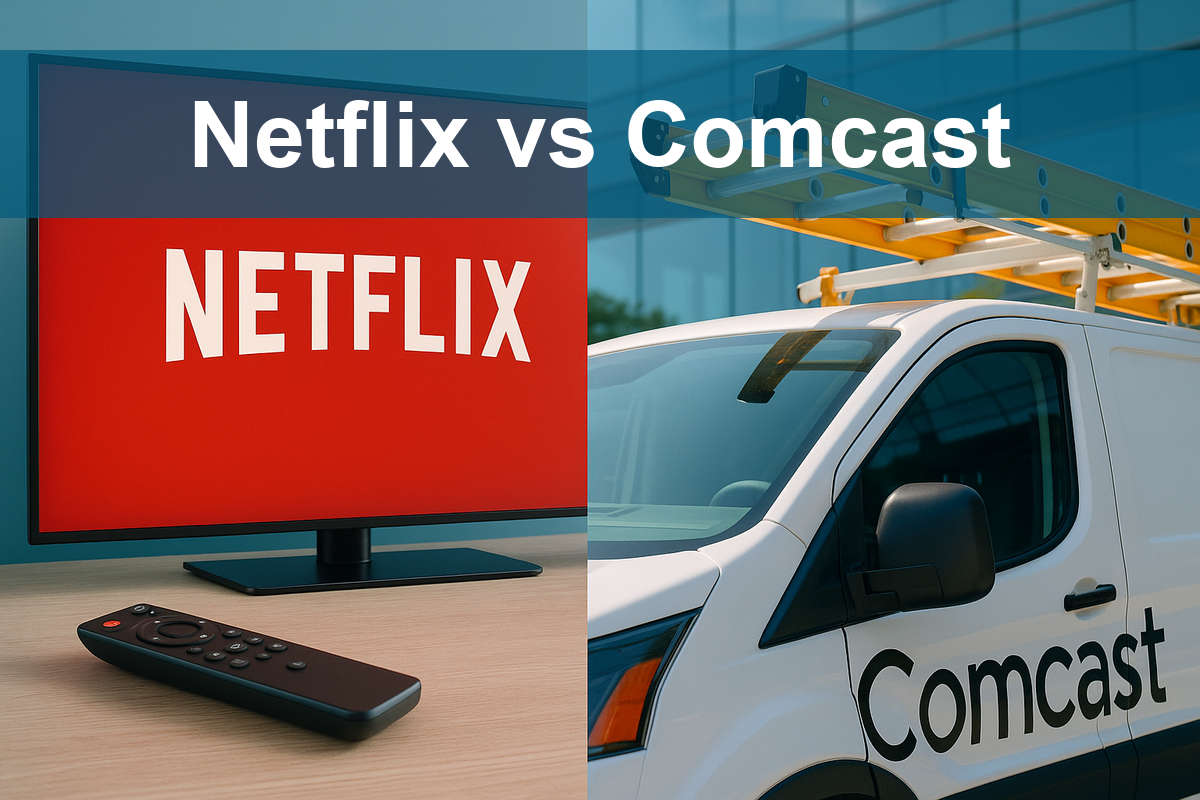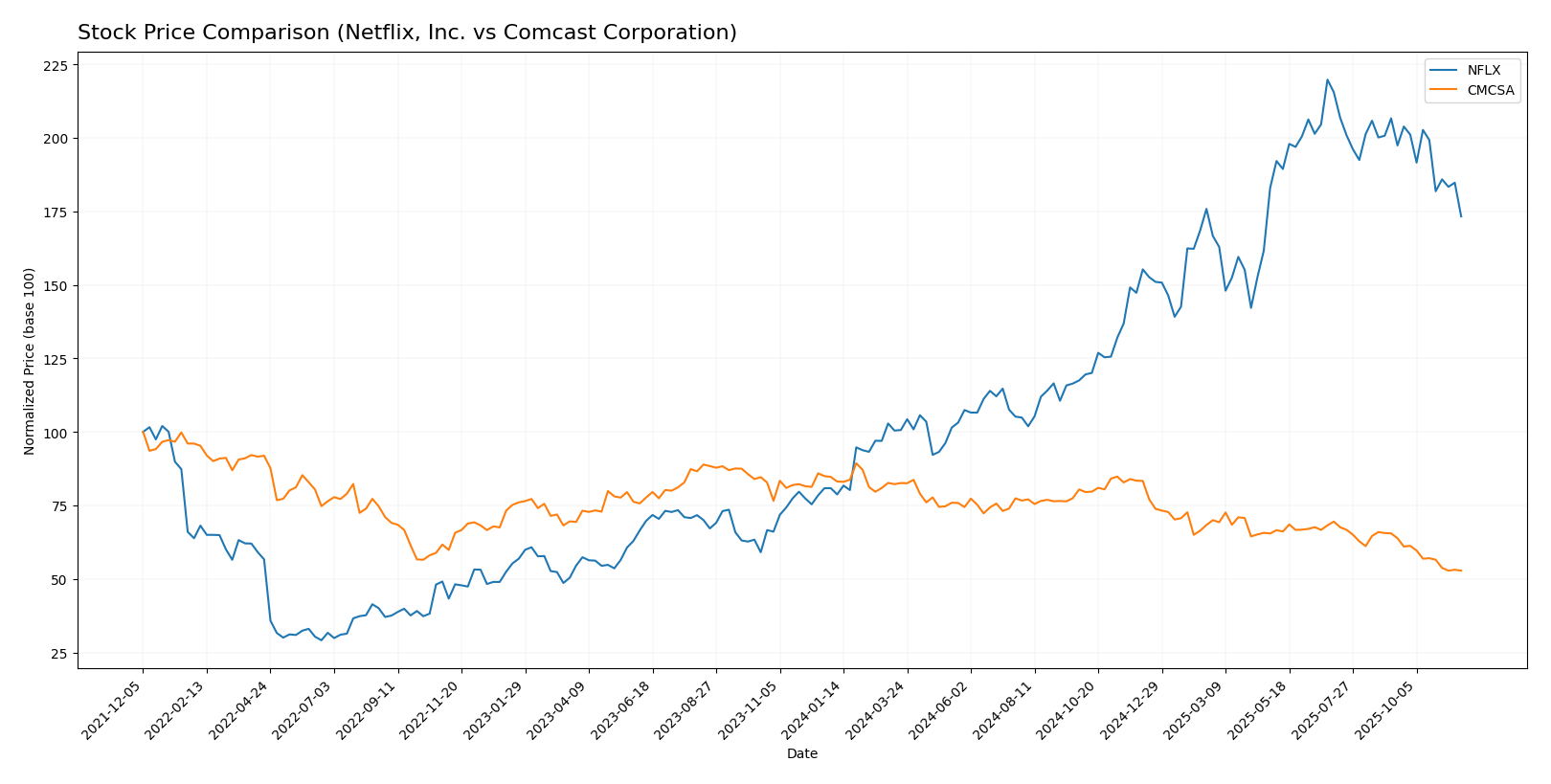In today’s rapidly evolving entertainment landscape, Netflix, Inc. (NFLX) and Comcast Corporation (CMCSA) stand as two titans vying for viewer attention. While Netflix revolutionized content streaming, Comcast offers a diverse portfolio that spans telecommunications and media. Their overlapping interests in streaming services and innovation strategies make this comparison particularly compelling. As we delve into their financials and market positioning, I aim to help you determine which of these companies presents the most intriguing opportunity for your investment portfolio.

Table of contents
Company Overview
Netflix, Inc. Overview
Netflix, Inc. is a leading entertainment service provider specializing in streaming content, including TV series, documentaries, and feature films across diverse genres and languages. With approximately 222 million paid members in 190 countries, Netflix has established itself as a dominant player in the global streaming market. Founded in 1997 and headquartered in Los Gatos, California, the company has continually adapted its offerings to meet consumer demands, including mobile gaming and traditional DVD rental services. With a market capitalization of approximately $456B, Netflix remains a key innovator in the entertainment industry, emphasizing quality content and seamless viewing experiences across various internet-connected devices.
Comcast Corporation Overview
Comcast Corporation is a multifaceted media and technology company based in Philadelphia, Pennsylvania. Operating through segments such as Cable Communications, Media, and Theme Parks, Comcast provides a broad array of services, including broadband, video, and voice under its Xfinity brand, as well as streaming via its Peacock platform. Established in 1963, Comcast has grown to include significant assets like NBCUniversal and theme parks in multiple countries. With a market cap of about $97B and a workforce of approximately 182K employees, Comcast is a powerful entity in the telecommunications and entertainment sectors, leveraging its diverse portfolio to deliver comprehensive media solutions.
Key similarities and differences
Both Netflix and Comcast operate within the Communication Services sector and offer streaming solutions, yet their business models diverge significantly. Netflix focuses exclusively on content streaming, while Comcast combines telecommunications, media production, and theme park operations, offering a more diversified revenue stream. This difference in focus influences their growth strategies and market positioning.
Income Statement Comparison
Below is a comparative analysis of the latest income statements for Netflix, Inc. and Comcast Corporation, providing key metrics that can guide your investment decisions.
| Metric | Netflix, Inc. | Comcast Corporation |
|---|---|---|
| Market Cap | 456B | 97B |
| Revenue | 39B | 124B |
| EBITDA | 26B | 38B |
| EBIT | 11B | 23B |
| Net Income | 8.71B | 16.19B |
| EPS | 2.03 | 4.17 |
| Fiscal Year | 2024 | 2024 |
Interpretation of Income Statement
In 2024, Netflix reported a revenue increase to 39B, up from 33.7B in 2023, indicating a strong growth trajectory. Conversely, Comcast’s revenue also rose to 124B, showing its stability in the telecommunications sector. Notably, Netflix’s net income grew significantly to 8.71B, reflecting improved operational efficiency and margin management, while Comcast’s net income was robust at 16.19B. However, Netflix’s growth rate appears to be accelerating, suggesting potential for further market capture, albeit with inherent risks in the competitive entertainment landscape. Both companies maintain healthy EBITDA margins, but Netflix’s growth dynamics may warrant closer scrutiny for future investment decisions.
Financial Ratios Comparison
The following table presents a comparative analysis of key financial metrics for Netflix, Inc. (NFLX) and Comcast Corporation (CMCSA) based on the most recent data available.
| Metric | NFLX | CMCSA |
|---|---|---|
| ROE | 35.21% | 18.92% |
| ROIC | 20.20% | 8.56% |
| P/E | 43.94 | 9.06 |
| P/B | 15.47 | 1.71 |
| Current Ratio | 1.22 | 0.68 |
| Quick Ratio | 1.22 | 0.68 |
| D/E | 0.73 | 1.16 |
| Debt-to-Assets | 33.55% | 36.66% |
| Interest Coverage | 14.49 | 5.64 |
| Asset Turnover | 0.73 | 0.46 |
| Fixed Asset Turnover | 24.47 | 1.98 |
| Payout ratio | 0% | 29.73% |
| Dividend yield | 0% | 3.28% |
Interpretation of Financial Ratios
In comparing these ratios, Netflix demonstrates stronger profitability (higher ROE and ROIC), indicating efficient use of equity and capital. Its high P/E and P/B ratios suggest that investors are willing to pay a premium for its growth potential. Conversely, Comcast’s lower ratios reflect more significant leverage (higher D/E) and a modest dividend yield, raising some concerns about financial stability. The current and quick ratios for Comcast indicate potential liquidity issues. Overall, while both companies have unique strengths, Netflix appears to be the more robust investment choice currently.
Dividend and Shareholder Returns
Netflix, Inc. (NFLX) does not pay dividends, focusing instead on reinvesting profits for growth. This strategy aligns with its high-growth phase, prioritizing content and technology investments. However, it engages in share buybacks to return value, mitigating dilution risks.
Conversely, Comcast Corporation (CMCSA) pays dividends with a payout ratio of approximately 30%. This approach supports shareholder returns while maintaining enough free cash flow for capital expenditures. Both strategies can foster long-term value creation, though NFLX’s growth-centric model carries higher risks.
Strategic Positioning
Netflix (NFLX) commands a significant share in the streaming market with approximately 222M paid members globally, positioning it as a leader in the entertainment sector. However, it faces intense competition from Comcast (CMCSA), which integrates media and technology with its extensive cable and streaming services, including Peacock. The competitive landscape is characterized by technological disruption and evolving consumer preferences, necessitating constant adaptation and innovation from both companies.
Stock Comparison
In this section, I will examine the stock price movements and trading dynamics of Netflix, Inc. (NFLX) and Comcast Corporation (CMCSA) over the past year, highlighting key price changes and trends.

Trend Analysis
Netflix, Inc. (NFLX) Over the past year, NFLX has experienced a remarkable price change of +126.91%, indicating a bullish trend. However, the recent analysis from September 14, 2025, to November 30, 2025, shows a decline of -9.47%, suggesting a temporary setback. The overall trend has demonstrated deceleration, and the standard deviation of 24.68 reflects notable volatility. The stock reached a high of 132.31 and a low of 47.41 during this period.
Comcast Corporation (CMCSA) In contrast, CMCSA has seen a significant price drop of -37.99% over the past year, indicating a bearish trend. The recent trend analysis from September 14, 2025, to November 30, 2025, reveals a further decline of -19.27%. Like NFLX, CMCSA’s overall trend also shows deceleration, with a standard deviation of 4.44, indicating lower volatility compared to NFLX. The stock’s highest price was 46.26, while the lowest was 26.69.
In summary, while NFLX is in a bullish trend overall despite a recent decline, CMCSA continues to face challenges with a bearish trend. As an investor, these insights can guide your decisions regarding portfolio adjustments.
Analyst Opinions
Recent recommendations for Netflix, Inc. (NFLX) indicate a “Hold” rating from analysts, reflecting concerns about its price-to-earnings ratio and overall valuation, despite solid return metrics. In contrast, Comcast Corporation (CMCSA) has received a “Buy” rating, with analysts highlighting its strong cash flow and solid equity returns as key drivers for growth. Notably, analysts like those from leading investment firms have voiced confidence in CMCSA’s performance. As of now, the consensus leans towards a “Buy” for CMCSA while NFLX remains a cautious “Hold.”
Stock Grades
I’ve gathered recent stock grades for two prominent companies—Netflix, Inc. (NFLX) and Comcast Corporation (CMCSA). These grades are provided by reputable grading companies, ensuring their reliability.
Netflix, Inc. Grades
| Grading Company | Action | New Grade | Date |
|---|---|---|---|
| Rosenblatt | maintain | Buy | 2025-11-28 |
| JP Morgan | maintain | Neutral | 2025-11-18 |
| Barclays | maintain | Equal Weight | 2025-11-18 |
| KGI Securities | upgrade | Outperform | 2025-11-03 |
| Canaccord Genuity | maintain | Buy | 2025-10-22 |
| Benchmark | maintain | Hold | 2025-10-22 |
| Wells Fargo | maintain | Overweight | 2025-10-22 |
| Needham | maintain | Buy | 2025-10-22 |
| Wedbush | maintain | Outperform | 2025-10-22 |
| Rosenblatt | maintain | Buy | 2025-10-22 |
Comcast Corporation Grades
| Grading Company | Action | New Grade | Date |
|---|---|---|---|
| Citigroup | maintain | Buy | 2025-11-03 |
| Barclays | maintain | Equal Weight | 2025-11-03 |
| Goldman Sachs | maintain | Neutral | 2025-11-03 |
| Bernstein | maintain | Market Perform | 2025-10-31 |
| Scotiabank | maintain | Sector Perform | 2025-10-31 |
| Evercore ISI Group | maintain | Outperform | 2025-10-31 |
| Benchmark | maintain | Buy | 2025-10-31 |
| TD Cowen | maintain | Buy | 2025-10-31 |
| JP Morgan | maintain | Neutral | 2025-10-31 |
| Seaport Global | downgrade | Neutral | 2025-10-31 |
Overall, Netflix maintains a strong position with most analysts recommending a “Buy” or “Outperform” rating, suggesting continued confidence in its growth potential. Conversely, Comcast shows a mix of “Buy” and “Neutral” grades, indicating a more cautious sentiment among analysts. This divergence highlights the importance of evaluating both companies carefully when considering portfolio decisions.
Target Prices
The consensus target prices for Netflix, Inc. and Comcast Corporation indicate potential upside from their current stock prices.
| Company | Target High | Target Low | Consensus |
|---|---|---|---|
| Netflix, Inc. (NFLX) | 1500 | 152 | 1295.58 |
| Comcast Corporation (CMCSA) | 41.5 | 28 | 34.59 |
For Netflix, the current price of $107.57 suggests significant growth potential compared to the consensus of $1295.58. Comcast, priced at $26.69, also shows upside relative to its consensus target of $34.59, highlighting overall positive analyst expectations for both companies.
Strengths and Weaknesses
In the following table, I will outline the strengths and weaknesses of Netflix, Inc. (NFLX) and Comcast Corporation (CMCSA) based on the most recent financial data.
| Criterion | Netflix, Inc. (NFLX) | Comcast Corporation (CMCSA) |
|---|---|---|
| Diversification | Limited to streaming services | High diversification across media, telecommunications, and theme parks |
| Profitability | Net Profit Margin: 22.34% | Net Profit Margin: 12.69% |
| Innovation | Strong focus on original content | Steady, but slower innovation in streaming |
| Global presence | Available in 190 countries | Primarily US-based, with some international offerings |
| Market Share | Leading in streaming with 222M subscribers | Strong in cable and broadband, but facing competition in streaming |
| Debt level | Debt-to-Equity: 0.73 | Debt-to-Equity: 1.17 |
Key takeaways: Netflix excels in profitability and innovation within the streaming market, while Comcast has a broader diversification strategy and strong presence in traditional media and telecommunications. Investors should weigh these aspects against their risk tolerance and investment goals.
Risk Analysis
The following table outlines the key risks associated with Netflix, Inc. (NFLX) and Comcast Corporation (CMCSA).
| Metric | Netflix, Inc. | Comcast Corporation |
|---|---|---|
| Market Risk | High | Moderate |
| Regulatory Risk | Moderate | High |
| Operational Risk | Moderate | Moderate |
| Environmental Risk | Low | Moderate |
| Geopolitical Risk | Moderate | High |
Both companies face significant market and regulatory risks, especially given the competitive landscape in streaming services. Recent content disputes and regulatory challenges could impact their operations and profitability.
Which one to choose?
When comparing Netflix, Inc. (NFLX) and Comcast Corporation (CMCSA), I find that both companies exhibit distinct fundamental strengths and weaknesses. NFLX has shown a bullish price trend with a significant price increase of 126.91% over the past year, although it recently experienced a downturn of 9.47%. Its price-to-earnings ratio of 43.94 indicates a higher valuation compared to CMCSA, which stands at 9.06, revealing potential undervaluation in the latter. CMCSA has a solid overall rating of A, while NFLX carries a B rating, reflecting its higher risk due to elevated debt levels and valuation metrics.
For investors seeking growth, NFLX may be appealing due to its aggressive market positioning, while those prioritizing stability might favor CMCSA, given its more attractive valuation and consistent performance. However, both companies face risks related to competition and market dependence.
Disclaimer: This article is not financial advice. Each investor is responsible for their own investment decisions.
Go further
I encourage you to read the complete analyses of Netflix, Inc. and Comcast Corporation to enhance your investment decisions:



